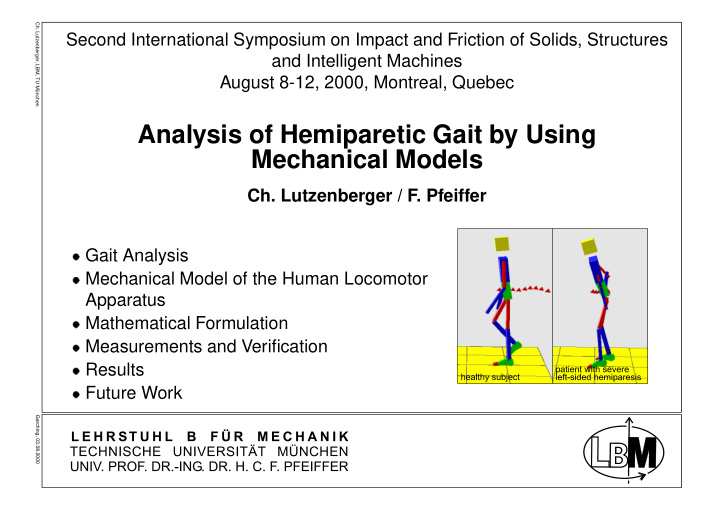



� � � � � � Ch. Lutzenberger, LBM, TU München Second International Symposium on Impact and Friction of Solids, Structures and Intelligent Machines August 8-12, 2000, Montreal, Quebec Analysis of Hemiparetic Gait by Using Mechanical Models Ch. Lutzenberger / F. Pfeiffer Gait Analysis Mechanical Model of the Human Locomotor Apparatus Mathematical Formulation Measurements and Verification Results Future Work Garching, 03.08.2000
� ✁ � � � � Ch. Lutzenberger, LBM, TU München Purpose: reduction of gait deviations diagnosis of gait deviations definition of therapy control and quantization of outcome of therapy Execution: performed by a physical therapist or doctor simulation and measurements provide additional information: – cadence, step length – joint angles – forces, torques, ... – EMG profiles more precise gait analysis Garching, 03.08.2000 1. Gait Analysis
Gait Analysis Common 1. Gait Analysis Ch. Lutzenberger, LBM, TU München Garching, 03.08.2000
� � � Ch. Lutzenberger, LBM, TU München and Extended Advantages of the extended approach: additional quantities for diagnosis – ground reaction forces – joint torques, power better understanding and therapy of gait deviations no force plates needed Garching, 03.08.2000 1. Gait Analysis
✂ � � � ✝✟ � � � � Ch. Lutzenberger, LBM, TU München Model properties: three-dimensional multibody-system 13 rigid bodies 12 joints with 3 degrees of freedom each 42 degrees of freedom at all joint torques ✂☎✄ ground reaction forces and torques ✆✞✝✟ parameter scaling for each patient Garching, 03.08.2000 2. Mechanical Model of the Human Locomotor Apparatus
☞ ✖ ✄ ✰ ✄ ✳ ✓ ✫ ✘ ✴ ★✵ ✰ ✕ ✖ ✖ ✥ ✝ ✟ ✶ ✕ ✖ ✭ ✝✟ ✬ ✮ ✖ ✝ ✟ ✛ ✮ ✝✟ ✘ ✭ ✬ ✰ ✖ ✝ ✟ ✯ ✜ ✰ ✝✟ ✘ ✥ ✷✸ ✬ ✂ ☞ ✏ ✌ ✡ ✥ ✄ ☞ ✏ ✝ ✒ ✟ ✥ ✄ ☞ ✏ ✂ ✄ ✥ ✧ ✡ ✏ ✮ ✰ ✝✟ ✰ ✝✟ ✹ ✘ ✕ ✖ ✄ ✄ ☞ ✍ ✂ ✌ ✡ ✘ ✎ ✩ � ✡ ✭ ✯ ✓ � ✕ ✖ ✢ ✂ ✄ ✥ ✢ ✂ ✛✜ ✫ ✌ ✡ ✍ ✎ ✒ ✡ ✛ ✘ ✧ ✒ � ✂ ☞ ✌ ✡ ✍ ✎ ✡ ✟ ✕ ✖ ✖ ✘ ✕ ✂ ✝ ✜ ☞ ✣ ✩ ✥ ✧ ✂ ✝✟ ✥ ✧ ✛ ✘ ✖ ✛✜ ✢ ✢ ✥ ✣ ✛ ✙ ✕ ✙ ✕ ✥ ★ ✕ ✖ ✢ ✖ ✥ ✧ ✖ ✥ ✧ ✘ ✂✪✄ equations of motion for the double support phase ✙✦✥ equations of motion for the single support phase ✙✦✥ ✢✤✣ ✠✻✺ ✯✲✱ ✖✚✙ ✠✻✺ ✆✗✝✟ 3. Mathematical Formulation ✆✗✝✟ ✖✚✙ ✠✻✺ Lagrangian function L ✆✗✝✟ ☞✔✓ ☞✔✓ inverse dynamics ☞✽✼ ✠☛✡✑✏ ✠☛✡✑✏ ✠✻✺ optimization ✠✻✺ ✠☛✡ ✠☛✡ ✠✻✺ Ch. Lutzenberger, LBM, TU München Garching, 03.08.2000
� ✁ � � � Ch. Lutzenberger, LBM, TU München Measurements performed in the neurological clinic in Bad Aibling, Germany contactless 3D motion analysis system with 58 markers (Optotrak) measurement of joint angles computation of joint angular velocities and accelerations by differentiation Verification of the Model good agreement of simulation results (bold solid line) with measurements (dotted line) and calculations (solid line) from litera- ture Garching, 03.08.2000 4. Measurements and Verification
� � � � Ch. Lutzenberger, LBM, TU München Animation Advantages compared to common recording techniques: view the disturbed gait pattern under different angles zoom on details oppose the impaired to a healthy gait pattern facil storage Garching, 03.08.2000 5. Results
Ch. Lutzenberger, LBM, TU München Evaluation of Degree of Outcome of Therapy Hemiparesis A: healthy subject A: healthy subject B: patient with moderate hemiparesis D1, D2, D3: patient D in different stages of C, D: patients with severe hemiparesis physiotherapy (physio) Garching, 03.08.2000 5. Results
� � � � � Ch. Lutzenberger, LBM, TU München Kinematic Characteristics of Hemiparetic Gait excessive lateral movement of body’s center of mass high lateral ground reaction forces on the affected side low peak torques in all joints of the lower limb lower peak torques on the affected than on the unaffected side energy for propulsion results mainly from the unaffected side Garching, 03.08.2000 5. Results
� � � Ch. Lutzenberger, LBM, TU München Model-based Functional Electrical Stimulation (FES) for Therapy of Hemiparesis Therapy of hemiparetics physiotherapy treadmill walking new treatment: FES FES: artificial stimulation of muscles on the affected side of the patient Advantage: significant improvement of therapy Goal: correct the impaired gait pattern Garching, 03.08.2000 6. Future Work
Recommend
More recommend